Why grow rainforest plants?
Rainforest species display a staggering diversity of shape, colour, size and appearance. Their attractiveness is due not only to their flowers, spectacular as some of these are, but to the plant forms, leaf shapes, colourful new growth or bright fruits. Unlike many plants from the drier parts of Australia, rainforest plants distribute their seeds through birds or flying foxes rather than the wind. The fruits need to appeal to dispersers so they often develop brilliant colours and juicy or sweet flesh. Young leaf growth can be very striking and sometimes even more impressive than the flowers.
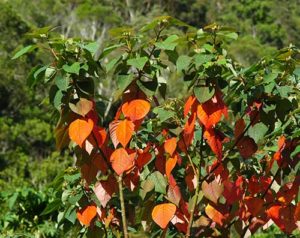
Bleeding Heart (Homalanthus populifolius) is ornamental and bird-attracting as well as being a fast-growing pioneer species.
Rainforest plants are remarkably hardy and adaptable. Whilst rainforest ecosystems are fragile and can be damaged or destroyed by heavy-handed or prolonged interference, individual plants in gardens have proved able to survive anywhere that conventional exotics are grown. The huge latitudinal and altitudinal range of some species gives them an ability to grow almost anywhere if provided with basic care.
Fire-retardant qualities are exhibited by most rainforest species, including those from naturally dry areas. They can be planted to form a ‘green fire-break’ that, although it may not stop a fire, will reduce its speed and intensity, especially when compared with fire-promoting vegetation such as eucalypts and wattles. Although most rainforest plants are severely damaged by fire and their sensitivity to fire is a defining characteristic, many can in fact recover from an occasional burn.
Many Australian rainforest plants are grown specifically for their ability to attract birds and butterflies. Lorikeets, rosellas, bower birds, native pigeons and many others are enticed by the flowers or fruits. Figs, laurels and members of the Sapindaceae family are particularly useful to birds and should be planted where space permits. Host plants for butterfly larvae or food plants for adults are always worth planting for the added interest they bring to gardens.
Some rainforest plants are increasingly grown as commercial or home-grown bush food, particularly now that high levels of antioxidant phytochemicals have been found in several species. Many gardeners who restrict themselves to growing only ‘edible-or-local’ plants, find that some rainforest species such as Brush Cherry (Syzygium australe) fit both requirements.
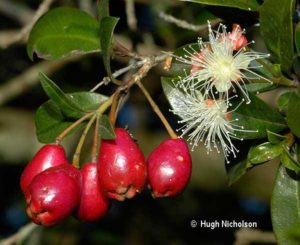
The tasty fruits of Brush Cherry (Syzygium australe) are a bonus.
How rainforest plants behave.
In gardens, plants may appear dramatically different from their forest-grown counterparts. Shrubs or trees often grow tall, slender or straggling under a heavy forest canopy, where restricted light forces growth upward. In the open they develop a shorter, denser and more rounded appearance. As a general rule, a tree grown in the open will be one third the size of the same species in the rainforest.
Some rainforest plants grow very rapidly: pioneer species can put on 3 m or more each year where high levels of soil nutrients are available. Others may be extremely unhurried. An impression of rainforest plants as slow growers has arisen from the ability of many species to wait indefinitely for a space. A closed canopy restricts active growth so severely that a small tree of 2–3 m may be many years old. When a large tree falls and rifts the canopy, formerly dormant saplings grow quickly in the improved light. The fastest sapling fills the space, consigning the others to more years of waiting.
Most of the shrubs and trees are very long-lived and will not need to be replaced. Even the so-called ‘short-lived’ pioneers last at least twenty years.
Natural growing conditions for different species can vary greatly, ranging from exposure to sun and salt winds on coastal headlands to perpetually wet and cool mountain gullies, and from pure sand to boggy clays. In addition, some species are adapted to recolonising disturbed areas after natural catastrophes such as isolated tree falls, cyclones or landslips. Most of the so-called ‘climax’ species, which develop in the initial shelter of pioneer trees and which are considered to be sensitive, are well-adapted to full sun on their canopies, low humidity and a broad range of temperatures. A tolerance of shade does not imply a requirement for it.
Many of the most successful garden plants originated in the tropical, subtropical or temperate rainforest in other countries. Selected for the best forms, grown in open garden conditions, and given water and fertilizer, they excel and are deservedly popular. Australian rainforest plants are often more attractive in the garden than exotic species but they are little known as yet and have not undergone extensive breeding and development.
Neither a large garden nor years of gardening expertise are required to grow rainforest plants at home. Australian rainforest plants can be grown in most gardens provided they are protected from extremes of heat, cold and exposure. Depending on the space available, they can be used to underplant an existing garden with extra species, or to form shrubberies either on their own or in combination with other natives or exotics. They can also be used as specimen shrubs or trees in prominent positions or as small rainforest communities with trees, shrubs, groundcovers, vines and ferns.
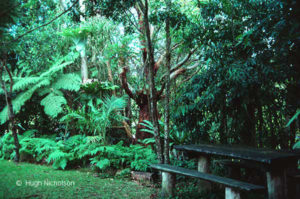
A selection of rainforest ferns and palms can add a lush look to a corner of your garden.
Planning.
Species should be selected that are suitable for the site’s latitude, altitude, soil type and degree of exposure. Preference should be given to local species that grow within about 30 km of the site. Plants from other areas may not perform as well or, conversely, may become weedy and threaten the local bushland.
If possible, planting sites should be chosen which are sheltered at least to some extent by existing trees, buildings or fences. Most rainforest plants will tolerate strong sunlight if desiccating winds are minimised and frost damage lessened by the proximity of other trees. In new or sparsely-planted gardens there is little choice, so hardy sun-loving plants should be used. Rapid cover can be provided by many of the pioneer plants such as Brown Kurrajong, Pink Ash, Macaranga or Bleeding Heart. Well-drained soil is preferable though there are various species which can tolerate poor drainage.
Spacing depends entirely on the desired shape of the plants. If grown singly, most rainforest trees and shrubs form a very rounded, bushy outline. Group plantings can be spaced at roughly 3 m intervals to allow some room for development but many gardeners prefer closer planting to achieve quick cover. Dense planting results in taller and more spindly trees.
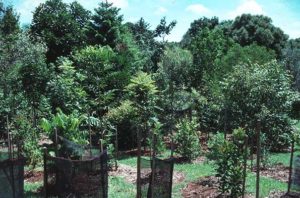
Successive plantings, with protection from browsers and frost, allows the gardener to put adequate time into the establishment of each phase of the venture.
Mulching.
Heavy mulching is important in providing humus to support healthy populations of soil organisms. It also keeps the root-zone cool, which is of more concern to these plants than overhead shade. Within two or three years, the combination of mulching and dense foliage can almost completely eliminate weeds. Most garden refuse, lawn clippings, leaves and even branches can be used to build up humus. Once a canopy is established, conditions at ground level will remain moist, helping to break down the organic matter rapidly. If mulch cannot be provided in the first few years, competition from weeds and grass must be kept down by other means, such as weed-mat or cardboard, or as an absolutely last resort, the occasional use of low-toxicity herbicide.
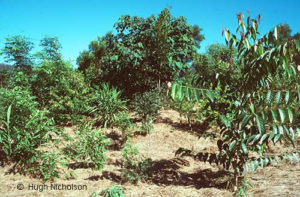
Heavy mulching helps eliminate weeds from this planting – 18 months old in the background and 7 months in the foreground.
Watering.
Water is an important factor in keeping rainforest plants healthy, although they do not need more water than is received by the average garden of conventional exotics. Crucial times for water needs are the first three months after planting and during hot, dry windy summers such as Melbourne experiences. A good soak once a week during dry spells may be necessary for young plants, but established ones are remarkably resilient, especially if mulched well.
As many Australian cities become thirstier due to climate change, it will become increasingly important to grow species that can cope with less watering, less rainfall, more direct sunlight and higher temperatures. Some rainforest species from the vine scrubs and monsoon forests are well adapted to dry conditions. On the other hand some areas such as the far north-east may become wetter and will also need careful selection of species.
Fertilizing.
Clearly, deep rich soil is the ideal. However, most gardeners work with something less. In rainforests, soil nutrients are recycled rapidly as fallen leaves decompose and are again made available to the roots. To hasten the establishment of this natural cycle, fertilizers can be used in the early years, helping the plants to grow quickly and begin producing leaf litter for their own use. Compost and old manure are the best natural fertilizers but if these are not available then a handful of slow release chemical fertilizer twice a year, or a high nitrogen quick-release fertilizer such as chook manure three or four times during spring, summer and autumn, will give encouraging results. All artificial fertilizers should be watered in well and covered with mulch. Lime or dolomite should be applied with caution as acidic soils are normal for most rainforest plants.
Pruning.
Most rainforest plants respond well to pruning, usually developing a very bushy crown of new growth. Pruning can be carried out at any time of the year but the bare appearance will be covered soonest if done in the warmer months. Water and fertilizer should be provided to encourage fresh new growth. Pinching out the tips of young plants to encourage low branching is preferable to savage pruning later. Alternatively, low branches can be removed to induce an open park-like appearance.
Growing rainforest plants in tubs.
Many rainforest plants are very handsome in containers. Their unusual foliage and bright tips are the main attraction but some species, particularly when cutting-grown, will produce flowers and fruits while still small. Some can also be used as indoor plants, varying only in the length of time they continue to look attractive. That may range from two weeks to two years. If grown in portable tubs they can be kept outside and moved inside when in flower or new leaf. Growing in tubs may also be a good way of growing species that do not like local soil conditions or cannot take droughts.
In natural conditions, water and soil nutrients are usually available at the higher soil levels so a deep penetrating tap root is not required and in fact often dies after a few years and is replaced by a mass of lateral roots. If root-space is re犀利士
stricted the plant simply reduces its growth rate. For these reasons healthy container-grown rainforest plants can last for some years, growing quite slowly, and can then be planted out without the problems of a curled tap root.
These plants can be grown as single specimens, or planted closely in groups. In large containers a mixed planting gives an interesting and original effect. When grown for use on patios or verandahs they look splendid in bright light with some protection from wind and hot sun. However species can be chosen which will cope with a perpetually shady south-facing wall or with full sun on the northern side.
Cultivation requirements for tub plants are similar to those for garden-grown plants, with the exception of the soil mix. A plant growing well in garden soil will not thrive if that same soil is used in a tub, as drainage will almost certainly be inadequate. The potting medium must be at least one third sand or aggregate and the rest should be highly fibrous water-holding material, such as good quality compost, with a small amount of soil. Frequent light pruning, coupled with the use of slow-release fertilizer, will produce shapely plants with dense foliage. Water needs obviously depend on the soil mix, the season, the plant and the position. However, it is best to err on the side of under-watering because wilting due to dryness can be easily rectified whilst wilting from root fungal attack cannot. Rainforest plants are very resistant to soil fungi but constant over-watering usually causes root problems.
Repotting should not be undertaken too frequently nor into too large a container as this can induce very rapid leggy growth. Occasionally it can cause the death of the plant if large amounts of fertilizer become available to a very small root mass.
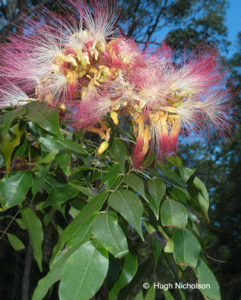
The ornamental Pink Laceflower (Archidendron grandiflorum) attracts Richmond Birdwing butterflies when in flower.
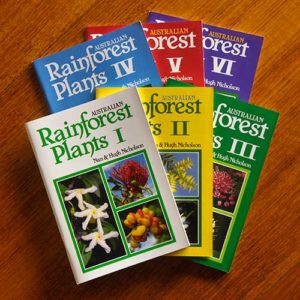 This post is an excerpt from a chapter in Australian Rainforest Plants Volume I. This is one of 6 volumes created and published by Nan (botanist & author) and Hugh Nicholson (photographer) of Terania Rainforest Publishing.
This post is an excerpt from a chapter in Australian Rainforest Plants Volume I. This is one of 6 volumes created and published by Nan (botanist & author) and Hugh Nicholson (photographer) of Terania Rainforest Publishing.
These 6 volumes have become references for beginners & experts alike, providing easy to understand information, identification & growing features of Australian rainforest.
For more information about these books or to order please go to the publications page on our website.

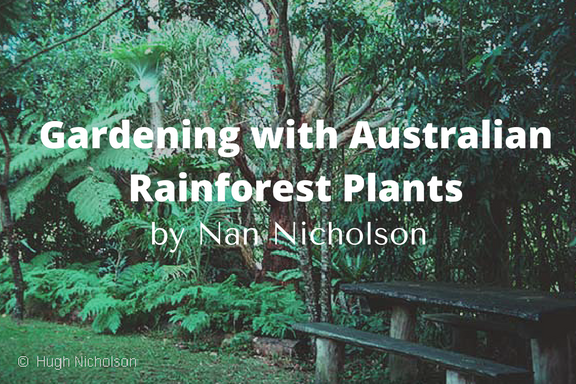

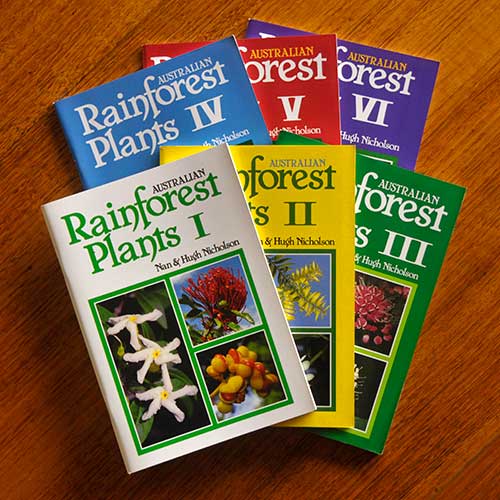
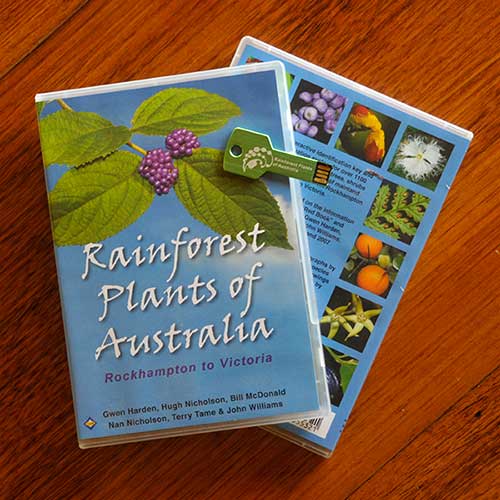
Alphitonia Excelsa.
I have a hillside of Red Ash that managed to be a pioneer after horrible erosion and cattle overstocking.
After thirty years when all the wattles and currajongs are dying and making a mess, they are powering.
Their grey canopy and now yellow flowers are magnificent.
I am wondering how much bigger can they get!
Currenly they are thicker than I am.
Hi Kali, Thanks for your message. I have always had a soft spot for Red Ash. They are such an adaptable species; growing from gaps in dense rainforest, to outliers in dry sclerophyll forest and even in monsoon scrubs in the Kimberley, WA. Floyd claims they can grow to 35 m with a trunk diameter of 125 cm.
As children, we were taken for long walks with my parents, in the natural surrounds of Cheltenham, my home town, England. I would have preferred good involvement natural history, but that came later in life while exploring my new home Australia. I am thrilled to now have flora and fauna, and marine life in my life, which answers all my questions about life, while revealing its amazing ways of growth, colours, of habits and differing habitats, and needs, leading to becoming so important as meeting like minded friends found the world over, to joining acivists constantly prepared for the next rally for the safety of all species by swelling the numbers.
I specialise in bird life and native orchids, and photography while everything else always catches my eye. What wonderful colours there are in the tropics, as recently returned for a while, before my varied nature home in Tasmania’s temperate rain forests of some ie Mt. Field National Park close to my home.
I bought your six volumes recently to absorb, perhaps return at nearing 82 to your tropics and plentiful birds and orchids, all going well. I musn’t give up, it’s all such a grand thing to do.
Margaret Bailes of Westerway, Tasmania